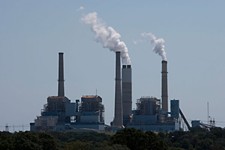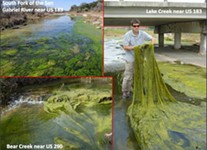Keeping Busy
Former regional EPA head Al Armendariz has a full agenda at the Sierra Club
By Nora Ankrum, Fri., Sept. 14, 2012
Al Armendariz, Texas' highest environmental official until last spring, moved to Austin this summer to join the Sierra Club as its senior campaign representative for the statewide Beyond Coal Campaign. The move follows his untimely resignation as administrator of the U.S. Environmental Protection Agency's South Central Region (Region 6), where he was in charge of enforcing EPA policy throughout Texas and surrounding states for 2½ years. His career at EPA was cut short by a flap over a 2010 video that surfaced earlier this year, showing Armendariz speaking at a public meeting in the small Texas town of Dish, north of Fort Worth. In the video, he espouses making examples out of lawbreakers, likening the practice to Romans conquering villages in the Mediterranean: "They'd find the first five guys they saw, and they'd crucify them," he says. Congressional Republicans called for Armendariz's head, widely circulating the video as proof of "EPA's crucifixion philosophy," in the words of Oklahoma Sen. James Inhofe. Armendariz resigned on April 30, feeling he'd become "too much of a distraction."
Though Armendariz's tenure at EPA was short, the list of agency actions during that time – especially those challenging Texas' environmental regulation – was long. Most notably, in 2010 EPA disapproved revisions, known as "flexible permitting," to Texas' Clean Air Act implementation plan, though the state had been issuing flex permits for many years. Texas challenged that decision and a string of other EPA actions in court.
The state scored its most recent win in this ongoing battle last month, thanks to a 5th Circuit Court opinion handed down Aug. 13 vacating EPA's disapproval. That decision, which puts the ball back in EPA's court on flex permitting, by no means signals the end of the war between EPA and Texas. Throw a dart at Attorney General Greg Abbott's calendar, and you'll likely hit a day when some court is refereeing a dispute between Texas and the EPA.
I spoke with Armendariz about the recent flex permit decision and other important rulings, including the recent decision (pending at the time of the interview) on Texas' challenge to EPA's Cross-State Air Pollution Rule. We also talked about his resignation and his plans going forward. In coming to Austin, he leaves behind his professorship at Southern Methodist University in Dallas, where he taught civil and environmental engineering. Now that he's at the Sierra Club, he plans to move Texas beyond coal, an endeavor that includes helping move Austin beyond the Fayette Power Project, a goal set by City Council with passage of Austin Energy's 2020 generation plan in 2011.
Austin Chronicle: Welcome to Austin. Have you lived here before?
Al Armendariz: I was born and raised in El Paso. I lived for a while as a kid in Houston, and then the last 10 years lived in Dallas, but only for a few weeks now in Austin. So I'm getting to see a lot of the state in my life, but first time in Austin.
AC: Is there anything you're looking forward to here on a personal level?
AA: Yeah, I've had the opportunity to get to know a number of the representatives of the environmental groups as well as people who work at the Legislature, elected officials and their staff, and people at the state agencies, and so I guess I'm looking forward to seeing them more often.
AC: And are you going to go to South by Southwest?
AA: [laughs] I'm not sure – if time allows, I might find myself over there.
AC: What are your thoughts as you look back over your tenure at EPA?
AA: I am very proud of the work that I did at EPA and really proud of being able to work with the great staff who are there at Region 6. We did a lot of great work together, and it really spanned all the different areas of EPA's authorities: clean air, clean water, safe drinking water, hazardous waste, oil spill response. Our region is highly industrialized; it has a growing population. My region included not just Texas but also Louisiana, Arkansas, Oklahoma, and New Mexico, and in several of the states, we had large emergency responses like the BP oil spill in 2010 as well as wildfires out in New Mexico that we were directly involved with. So it was a privilege to get to work with the staff, and I'm really proud of many things that we did.
AC: My understanding is that EPA worked in concert with several agencies on the BP oil spill.
AA: It was a grueling experience, but I am very proud of the EPA staff that I got to work with. EPA has an emergency response staff, we have wetland scientists, we have on-scene coordinators, and many other staff who were involved with me in responding to the oil spill. EPA worked in support of the [United States] Coast Guard, and the Coast Guard was the lead federal agency, and they asked EPA as well as a number of other federal agencies, like Fish and Wildlife Service as well as the military, to assist in the response, and it was very difficult work. It lasted many, many days and weeks and months, but I'm very proud of the work that we did.
AC: How big is the Region 6 staff?
AA: The regional office has about 850 full-time staff.
AC: All based in Dallas?
AA: The majority are in Dallas. There's also a number of staff in Houston and a small office in El Paso, as well.
AC: Obviously, EPA and Texas have had somewhat of an antagonistic relationship. I want to get your perspective on that, especially regarding recent and pending court decisions. The one I'm most familiar with is Coalition for Responsible Regulation v. EPA. What are the implications, in particular for Texas? [On June 26, the District of Columbia's U.S. Court of Appeals ruled in favor of EPA against the Coalition for Responsible Regulation; Texas was among the plaintiffs. The three-judge panel's unanimous ruling upheld several EPA decisions, including an "endangerment finding" that greenhouse gases threaten public health, a "Tailpipe Rule" setting greehouse gas emissions standards for automobiles, and "Tailoring" and "Timing" rules regarding greenhouse gas standards for stationary sources, such as coal-fired power plants.]
AA: Well, let me say this. I think that the court decision on greenhouse gases is probably the most important environmental decision that the federal courts have made in a very long time. I think it's going to be very, very important for Texas – the people and the industry in Texas. Climate change is by far the most significant environmental challenge that we have in this state. We're now in the second year of a drought affecting large portions of our state, and scientists are telling us that if we don't deal with climate change, we can expect more droughts – and more severe droughts – moving forward. So I don't think there's any question that climate change and drought are the most important environmental challenges that we have in Texas. So that court decision was critical. It upheld the federal government's authority to regulate greenhouse gases. It's going to allow the federal government to take steps to reduce greenhouse gas emissions from automobiles, power plants, other industrial facilities. And it's long overdue, but it's a fantastic step in the right direction.
AC: Some of the plaintiffs have petitioned for a rehearing. Do you expect that this might go to the Supreme Court eventually?
AA: I don't know. It might. It's hard to predict what people will spend their money on. Let me just say this: The EPA based its regulations of greenhouse gases directly on the Supreme Court's Massachusetts v. EPA decision, and the records for the rules that EPA developed – the endangerment finding, the tailoring rule, and others – flow directly from that Massachusetts v. EPA decision, so I suspect that, regardless of how the greenhouse gas decision is appealed, the agency is going to win. And the agency's authorities to regulate greenhouse gas emissions are going to be upheld by the D.C. circuit and by the Supreme Court in all efforts to undermine EPA's authority.
AC: Tell me about the proposed Las Brisas coal plant in Corpus Christi – it has to get a greenhouse gas permit, right?
AA: The Las Brisas facility is going through the process of getting a federal greenhouse permit because of the dates in several of EPA's greenhouse gas regulations. It did not complete the state permitting process before January 1 of 2011. Because of that it became subject to the Tailoring Rule provisions, which require greenhouse gas permitting for sources that are going through Clean Air Act permitting after January 1, 2011. So the Las Brisas facility has been involved in greenhouse gas permitting well before the June 2012 decision by the D.C. circuit that upheld the endangerment finding. Las Brisas has had an application into the federal government since late 2011, and it applied for that permit well before this court case.
AC: Because of the Tailoring Rule.
AA: Right.
AC: And the date of the Tailoring Rule is why some of the other plants [e.g., White Stallion in Matagorda County] don't have to apply?
AA: Correct. So there are facilities all over the country that received their air permits from state agencies before 2011, and those facilities are not required to get greenhouse gas permits. But facilities that get their permits after 2011 are required, and that's the reason that the Las Brisas facility has applied for and is waiting to receive the greenhouse gas permit from the EPA.
Got something to say on the subject? Send a letter to the editor.













